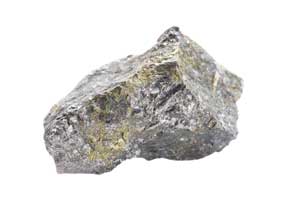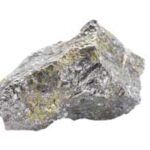When the majority of Americans hear the word “nickel” they generally think of the five-cent piece. Although familiar, the humble coin is only a small part of the metal’s long history and even longer list of uses. As a component of many common grades of stainless steel, nickel has played a vital role in creating the modern world. Now it is poised to play an even bigger part in the transition to green energy.
Already at more than US$60 billion a year1, the nickel market is projected to grow strongly in the next few decades as demand for stainless steel continues to rise, and demand for electric vehicles (EVs) accelerates. High energy density EV batteries rely on nickel as a primary component in the cathode (although it’s important to note that EV battery chemistries are evolving, and some, such as lithium iron phosphate (LFP) batteries do not use nickel). Beyond EVs, nickel is also important to the production of other forms of clean energy technology, including solar, wind, and nuclear.
Fortunately, there’s no shortage of nickel. It is one of the most common elements and can be found throughout the world. This gives the supply chain some protection against disruption; however, the sheer volume needed to meet forecasted demand is quite substantial, with some analysts predicting that demand could double over the next decade2.
This provides an opportunity for investors, as the industry will need large amounts of capital to expand production and keep up with demand.
What is Nickel?

Nickel is a highly ductile and oxidation-resistant metal, making it ideal for infrastructure, chemical production, communications, energy supply, environmental protection, and food preparation. Nickel is the fifth-most common element on earth, found extensively in the earth’s crust, at 80 parts per million, and core (mostly as nickel-iron alloy)3.
Significant nickel resources are found across the globe, and there are currently mining operations in more than 25 countries4. Nickel is also found on the deep sea floor5 and at small quantities in seawater; in meteorites; in animals and plants; and in certain beans as an essential component of some enzymes.
Rarely used in its purest form, nickel is usually produced as an alloy that provides ductility and strength at high temperatures, creating products that perform well in harsh environments, such as jet engines and nuclear reactors. Moreover, nickel is 100% recyclable, making it a valuable scrap metal.
Nickel Characteristics
Resistant
Nickel exhibits strong oxidation and corrosion resistance, making it valuable in creating durable, long-lasting products.
Critical
The US Geological Survey has named nickel one of 50 mineral commodities critical to the U.S. economy and national security.
Alloys well
Nickel is almost always combined with other metals to create alloys, contributing strength and resistance to oxidation.
Magnetic
Nickel is one of only four ferromagnetic metals, meaning it is magnetic at room temperature.
Catalytic
Nickel has catalytic properties, meaning it increases the speed of chemical reactions.
The History of Nickel
Humans have been using nickel since at least the third century BCE, when the Chinese used a zinc-nickel alloy known as white copper to make weapons, and later, coins6. In the 15th century, German miners discovered nickel ore, now called niccolite or arsenide, which resembled copper ore because of its red/brown color. Disappointed that they were unable to extract copper from it, the miners blamed a mythological demon called Nickel for playing a prank on them. They called this metal kupfernickel, meaning “copper demon”.7
The element was officially discovered in 1751 by the Swedish chemist Baron Axel Fredrik Cronstedt8. He used a procedure that heated kupfernickel with charcoal, enabling him to extract nickel. In 1775, another Swedish chemist, Torben Bergman9, was the first to produce pure nickel.
Large-scale nickel mining and smelting began in Norway in 1848 using a type of nickel ore called pyrrhotite. In 1889, James Riley, founder of the Richmond Iron and Steel Company, gave a presentation to the Iron and Steel Institute of Great Britain, outlining how nickel could be used to strengthen steel. Soon, nickel was in high demand for its use in steel production.
In the late 1800s, large nickel deposits were found in Canada, Russia, and South Africa. Nickel became a popular metal for coins around this time, largely because of its resistance to corrosion. In the US, it was given an extra boost after the Civil War, when people had begun hoarding coins made of gold and silver. Nickel was suggested as a substitute that people would be less likely to hoard.
During WWII, the demand for nickel for armaments and ammunition was so high that the composition of nickel coins, previously 25% nickel and 75% copper, was briefly changed to include no nickel at all. These days, 5¢, 10¢, 25¢, 50¢, and $1 U.S. coins, 20p, 50p, £1, and £2 UK coins, and €1 and €2 euro coins are all made with nickel alloys10.
Nickel is now one of the most widely used metals in the world. Globally, 3 million tonnes of new or primary nickel are produced and used annually11, and it can be found in over 300,000 products. The world’s largest nickel producer is Norilsk Nickel.
Nickel Uses
About 65-70% of the world’s nickel production is used for stainless steel12. From water pipes to industrial kitchens, stainless steel is valued for its ability to withstand corrosion and its antimicrobial qualities. Nickel is also used in other types of batteries, alloys, plating, alloy steels, castings, metal powders and other applications.
2022 forecast nickel use percentages13
- Stainless steel (65%)
- Batteries (16%)
- Alloys (9%)
- Plating (4%)
- Alloy steel (3%)
- Other (3% – mostly castings and powders)
Nickel use is divided into “first use” and “end use” applications. “First use” refers to nickel used in an intermediate product which is then processed before the ultimate end use14.
Figure 1: Nickel Usage
Source: Wood Mackenzie data, RCF analysis, February 2022
Specific Uses
- Stainless steel as an alloy (nickel and chromium with small amounts of silicon, manganese, and iron)
- Copper nickel alloy used in desalination plants
- Nickel-steel used for armor plating
- Rechargeable batteries (nickel cadmium)
- Nickel-metal hydride batteries in hybrid vehicles
- Nickel cobalt aluminum (NCA) and nickel manganese cobalt (NMC) EV batteries
- Coinage – the U.S. nickel is 25% nickel, 75% copper
- Boat propellor blades
- Turbine Blades
- Aerospace – leading consumer of nickel-base superalloys such as in turbine blades, discs and other parts of jet engines.
- Military
- Jewelry – but not as pure nickel since it causes a skin contact reaction called allergic contact dermatitis in some people.
Nickel Substitutes
Other metals can be substituted for nickel in certain circumstances:
- Iron and magnesium, which have a similar ionic radius, enabling substitution in some oxides and silicates15
- In construction, ultra-high chromium stainless steels have been used
- Titanium can be substituted for nickel metal or nickel-base alloys in corrosive chemical environments16.
Where is Nickel Mined?
The world’s nickel resources are currently estimated at almost 300 million tonnes and known nickel reserves have grown steadily over the past three decades17.
Five countries account for 50% of nickel world reserves:
- Australia (laterite and sulfide ore)
- Canada (sulfide ore)
- Indonesia (laterite ore)
- Russia (sulfide ore)
- South Africa (sulfide ore)
Australia accounts for approximately 20% of the world’s nickel resources and has significant reserves of both laterite-type and sulfide-type. Although Australia is very well balanced, all the recent production growth has been driven by Indonesian laterite ore developments. Brazil, Cuba, Philippines and New Caledonia also hold globally significant nickel reserves. Research indicates an estimated 290 million tons of nickel in deep-sea deposits18 as well, which may become accessible as deep-sea mining technologies improve.
Ore Types
There are two major types of nickel ore deposits in the earth’s crust, and mining and separation processes vary depending on the ore type.
Laterite-type (also called oxide-type; principal ore minerals are nickeliferous limonite and garnierite).
Laterite-type nickel mines are found primarily in equatorial regions, most notably Indonesia, the Philippines, Brazil, Cuba and New Caledonia. Laterites tend to be low-grade, bulk tonnage nickel deposits used for nickel pig iron and ferronickel, and account for 62.4% of nickel on the market today. Laterite-type deposits are near the surface, so open-pit mining is generally used. The ore contains other valuable metals besides nickel19, which helps make separation more economically viable.
Magmatic Sulfide (principal ore mineral is pentlandite)20
Magmatic sulfide deposits (nickel sulfides) are found in Siberia, Canada, and South Africa. High-grade sulfide deposits are used to make nickel metal and nickel sulfate, which is used in making lithium batteries. Sulfides account for 37.5% of the nickel market. Reserves are deep underground and are thus more expensive to extract than laterites, but the ore is relatively cheaper to separate.
Two Classes of Primary Production
Primary nickel production is divided into two main categories: Class 1 nickel contains more than 99.8% nickel, makes up about 55% of the total nickel mining output, and is widely used in making rechargeable batteries21. Class 2 includes iron bearing nickel, inclusive of nickel pig iron (NPI) and ferronickel, both of which are widely used in stainless steel production. Only Class 1 nickel is traded on the London Metal Exchange (LME).
The Rise of NPI
In the year 2000, nickel was plentiful and trading at US$5k–US$7k/tonne. Its primary uses were stainless steel, superalloys, and electroplating. But the nickel market was hit hard by underinvestment just as the Chinese economy was starting to rise. By 2007, nickel had become scarce, and the price rose almost ten-fold from US$5k to US$51k22. In response to the shortage, China adapted an old technology of beneficiating (i.e., creating higher grade) nickel laterite ores using pyrometallurgy. Their first attempts were crude, but in 2009, they combined this approach with the use of rotary kiln electric furnaces (RKEFs) to produce an abundance of inexpensive high-grade nickel pig iron (NPI), also known as ferro-nickel (FeNi).
The magnitude of this success was similar in scale to the shale revolution in the oil & gas sector. The Chinese were able to leverage existing iron in nickel laterite deposits to more efficiently produce the largest nickel end-market product: stainless steel. In 2010, China switched from being a net importer to a net exporter of stainless steel, and by 2013, Chinese NPI supplied 25% of the global stainless steel market.
Today, the Chinese economy has accelerated nickel demand from 2010 to 2020 at a CAGR of 5%, and Chinese stainless steel producers are the most efficient operators in the space. Asia represents 82% of world demand, with 60% going to China23.
New Opportunities, New Demand: The Future of Nickel
There’s no question that nickel is both necessary and abundant – but that doesn’t mean the global supply chain is without challenges.
Until recently, the global nickel market was driven by demand for stainless steel, which uses both high-purity Class 1 and lower-purity Class 2 nickel products. By 2015, however, a new demand source for nickel had emerged: high energy density batteries. The Tesla/Panasonic NCA (nickel, cobalt, aluminium) batteries, and the competing, more broadly adopted NCM (nickel, cobalt, manganese) batteries have been heralded as the most advanced formulation for high density (power + range) batteries for electric vehicles.
Currently, 80% of EV lithium-ion batteries forecast to be sold in 2022 are NCM and NCA high-nickel chemistry based (295 MWh of a global total 371 MWh), where the remaining 20% balance is made up of LFP. High-nickel containing batteries (NCM and NCA) expected to rise to nearly 1320 MWh by 203024 as the demand for green energy and electric vehicles grows.
Indonesia has emerged as a major force in the industry, now producing 50% of the world’s nickel supply, following a period of massive foreign investment that began in 2014. Historically, Indonesian nickel production was directed at the stainless steel (or class 2) nickel market, given the country’s nickel laterite (iron-bearing) ore endowment. Saprolite ore is not generally suited to producing Class 1 nickel, however limonite ore can be used to produce mixed hydroxide precipitate (MHP) or mixed sulphide precipitate (MSP), which can be further refined to Class 1 nickel needed to produce battery cathodes25.
Given current trends, Class 1 nickel is likely to be undersupplied for the near future. One factor complicating the outlook for nickel demand is that both stainless steel and batteries are now more efficiently produced from nickel intermediate products, as opposed to pure nickel metal. But while that may impact how it is processed and traded on the London Metal Exchange, overall demand for the commodity will continue to rise due to its usefulness in so many applications.
In the past 20 years, nickel production has grown from 1.1MT (2001) to 3MT (2022)26, and the world needs it to double again to 5.0MT by 2032 to meet market needs27. Known nickel resources can handle this growth, so long as Indonesian project development success continues on trend.
ESG Issues in Nickel Mining
The nickel industry faces the challenge of simultaneously doubling its output while adhering to environmental, social, and corporate governance (ESG) requirements.
The exact ESG issues for nickel mines vary, as every operation is unique. Mines, refineries, and smelting operations are spread out across the globe, each dealing with a unique blend of political, socio-economic, and transportation systems; also, ore types, climates, and local employment factors. Some of the primary environmental considerations across the space are carbon dioxide emissions, land use, and tailings28.
As laterite resources tend to occur in tropical areas, these mines are often constructed in or near rainforests. Their open-pit operations may be spread out over a wide area and are thus more likely to have a significant effect on local biodiversity29. Access to workers may also be limited, resulting in a potentially disruptive influx of expat labor. However, such environmental and social impacts can be mitigated by adhering to Good International Industry Practice (GIIP)30 guidelines and investing in training for local workers.
Sulfide projects, on the other hand, tend to be deep with a smaller surface footprint than laterite mines, and are more often found in countries with highly developed environmental regulations and strong labor forces. However, they tend to be lower grade and lower recovery, meaning higher volumes and more waste. This means more fuel consumed in transportation, more emissions, and higher operational costs31.
Countries are beginning to institute legislation such as the EU’s Carbon Border Adjustment Mechanism (CBAM)32 that will ensure that imported products meets environmental and social safeguard standards across the entire supply chain. That means that nickel mines, even those based in less regulated countries, will benefit in the near future by switching to renewable power sources, electric vehicles, and more responsible tailing methods.
How Nickel Supports the SDGs33
Nickel is an essential element of energy, transportation, food, and clean water solutions, contributing to several of the United Nation’s Sustainable Development Goals, including:
- #6 Clean Water and Sanitation
- #7 Affordable and Clean Energy
- #9 Industry, Innovation and Infrastructure
- #11 Sustainable Cities and Communities
- #12 Responsible Consumption and Production
- #13 Climate Action
- #14 Life Below Water
As a key component of the majority of stainless steel, nickel plays a vital role in delivering clean water to communities throughout the world as well as in processing, storing, and distributing food, because it helps provide working and storage surfaces that can be easily cleaned and disinfected. Nickel is also important to urban infrastructure as it is used in stainless steel rebar and other structural materials. This makes it vital to the creation of larger, more sustainable cities.
Nickel is also crucial to various environmental objectives. As a critical component of lithium batteries, wind turbines, solar cells, and other forms of clean energy, nickel is already helping combat global climate change and reduce carbon emissions. Durable and corrosion-resistant, nickel can reduce environmental costs by prolonging the useful life of many products. Nickel alloys and nickel-containing stainless steel contribute to cleaner oceans by minimizing sulphur emissions from ships.
Finally, nickel is 100% recyclable, meaning it can be recycled into new materials with no loss of quality.
Nickel as an Investment Opportunity25
Nickel is an example of a metal with demand side expansion potential, driven by factors such the energy transition. However, investment opportunity may be limited by supply-side expansion. There is nickel supply-side expansion from Indonesia, along with practical bridging of the Class 1 vs. Class 2 nickel divide via nickel matte production. The nickel industrial parks in Indonesia can now flexibly shift between ferronickel and nickel matte production, in addition to seeing greater nickel and cobalt chemical participation in these upstream facilities.
Nickel supply was growing at 4-5%, driven by Indonesian ferronickel growth. In 2022, nickel supply is forecasted to more than triple to 17.4%, before settling back to 5–7% growth.
Strong demand-side drivers which require further nickel supply expansion, coupled with supply chain resilience concerns, and Inflation Reduction Act incentives may point to investment opportunity in the nickel market.
However, it’s important to remain selective given the complexities related to ESG, jurisdiction and nickel product/market considerations. That is why it’s a necessity to work experienced managers that have both technical expertise and market experience before venturing too deep in the global nickel market.
Nickel FAQs
Is nickel one of the precious metals?
Precious, or noble, metals are relatively scarce, do not corrode, and resist oxidation. Base metals, on the other hand, are relatively common and susceptible to oxidation. Despite being relatively resistant to oxidation and corrosion, nickel is among the most common base metals, others being copper, lead, tin, aluminum, and zinc.
What is nickel and its uses?
Nickel is a silvery white metallic element. Rarely used in its pure form, nickel is most often used to make strong, heat-resistant alloys, in particular stainless steel (69% of the world’s current nickel supply goes to stainless steel). That makes it particularly valuable for equipment used in harsh conditions such as refineries, jet engines, and chemical plants. It is also a key component of lithium batteries. Except for the penny, all currently circulating US coins are made of alloys that include nickel.
What is nickel made of?
Nickel is not an alloy or compound but an actual element, meaning it cannot be broken down further by any chemical reactions. Nickel is rarely used by itself for industrial purposes, however. Most often, it is combined with other metals to create strong alloys. The US “nickel” (5-cent) coins are 25% nickel and 75% copper.
Like what you’re reading? Subscribe to our top stories.
Source of Data
1 International Nickel Study Group forecasts rising nickel demand in 2022. https://www.mining.com/international-nickel-study-group-forecasts-rising-nickel-demand-in-2022/
2 AME, BNEF, S&P Global data, RCF Analysis, 1 September 2022.
3 Nickel Institute, About nickel. https://nickelinstitute.org/en/about-nickel-and-its-applications
4 Nickel Institute, The life of Ni. https://nickelinstitute.org/media/1190/thelifeofni.pdf
5 Facts About Nickel. https://geology.com/usgs/uses-of-nickel/
6 Nickel. https://en.wikipedia.org/wiki/Nickel
7 Nickel Institute, History of nickel. https://nickelinstitute.org/en/about-nickel-and-its-applications/history-of-nickel/
8 The Element Nickel. https://education.jlab.org/itselemental/ele028.html
9 Torben Bergman. https://en.wikipedia.org/wiki/Torbern_Bergman
10 Nickel. https://en.wikipedia.org/wiki/Nickel
11 International Nickel Study Group, Press Release, 18 October 2022. https://insg.org/wp-content/uploads/2022/10/pressrel_INSG_Press_Release_October2022aksjfilj.pdf
12 Nickel Institute, Properties of nickel. https://nickelinstitute.org/en/about-nickel-and-its-applications/properties-of-nickel/
13 Macquarie nickel forecast data, November 2022.
14 Nickel Institute, 01 Nickel properties. https://nickelinstitute.org/en/about-nickel-and-its-applications/#01-nickel-properties
15 USGS, Nickel Statistics and Information. https://www.usgs.gov/centers/national-minerals-information-center/nickel-statistics-and-information
16 USGS, Mineral Commodity Summaries 2022: Nickel. https://pubs.usgs.gov/periodicals/mcs2022/mcs2022-nickel.pdf
17 Nickel Metal Profile. https://www.thoughtco.com/metal-profile-nickel-2340147
18 Nickel Institute, About nickel. https://nickelinstitute.org/en/about-nickel-and-its-applications
19 An innovative process for extracting scandium from nickeliferous laterite ore: Carbothermic reduction followed by NaOH cracking. https://www.sciencedirect.com/science/article/abs/pii/S0304386X19304402
20 Facts About Nickel. https://www.livescience.com/29327-nickel.html
21 Nickel: The Secret Driver of the Battery Revolution. https://www.visualcapitalist.com/nickel-secret-driver-battery-revolution
22 YCharts, Nickel Price. https://ycharts.com/indicators/nickel_price
23 INSG, About Nickel: Production, Usage and Price. https://insg.org/index.php/about-nickel/production-usage
24 E Source EV Forecast Database Q4 2021.
25 CSIS, Indonesia’s Nickel Industrial Strategy. https://www.csis.org/analysis/indonesias-nickel-industrial-strategy
26 INSG, About Nickel: Production, Usage and Price. https://insg.org/index.php/about-nickel/production-usage
27 AME, BNEF, S&P Global data, RCF Analysis, 1 September 2022.
28 ESG in Nickel Mining: Key Factors to Consider. https://investingnews.com/esg-in-nickel-mining
29 ESG in Nickel Mining: Key Factors to Consider. https://investingnews.com/esg-in-nickel-mining
30 Environmental, Health and Safety Guidelines for Mining. https://www.ifc.org/wps/wcm/connect/595149ed-8bef-4241-8d7c-50e91d8e459d/Final+-+Mining.pdf?MOD=AJPERES&CVID=jqezAit&id=1323153264157/
31 ESG in Nickel Mining: Key Factors to Consider. https://investingnews.com/esg-in-nickel-mining/
32 Carbon Border Adjustment Mechanism: Questions and Answers. https://ec.europa.eu/commission/presscorner/detail/en/qanda_21_3661
33 Nickel Institute, Nickel and the Sustainable Development Goals. https://nickelinstitute.org/en/sdgs
Important Information
This information should not be deemed to be a recommendation of any specific commodity, company, or security.
This material is provided for educational purposes only and should not be construed as research. The information presented is not a complete analysis of the nickel and/or commodities landscape. The opinions expressed may change as subsequent conditions vary. The information and opinions contained in this material are derived from proprietary and non-proprietary sources deemed by Resource Capital Funds and/or its affiliates (together, “RCF”) to be reliable. No representation is made that this information is accurate or complete. There is no guarantee that any forecasts made will come to pass. Reliance upon information in this material is at the sole discretion of the reader.
None of the information constitutes a recommendation by RCF, or an offer to sell, or a solicitation of any offer to buy or sell any securities, product or service. The information is not intended to provide investment advice. RCF does not guarantee the suitability or potential value of any particular investment. The information contained herein may not be relied upon by you in evaluating the merits of investing in any investment.
Investing involves risk, including possible loss of principal.
Contents
Nickel Quick Facts37

| Melting Point | 2651 °F (1455 °C) |
|---|---|
| Boiling Point | 4946 °F (2730 °C) |
| Thermal Conductivity | 97.5 W m 1 K 1 |
| Thermal Expansion | 17-18 × 10−6°C−1 |
| Electrical Resistivity | 6.99×10−8 |
| Electron Configuration | [Ar] 3d8 4s2 or [Ar] 3d9 4s1 |
| Word Origin | Named after "Nick" or "Nickel" a mythological German demon. |
| Color | Silvery white, shiny appearance |

